The Effectiveness of Revised Clinical Practice Guideline for Postoperative Pain Management in the Recovery Room Compared with the Previous Guideline
Main Article Content
Abstract
Background: The postoperative pain guideline has been implemented, but two-third of moderate to severe pain patients were discharged from the recovery room untreated. The pain guideline was revised dosages of opioids depending on pain intensity instead of body weight (BW), morphine was injected 2 mg for BW 30-50 kg and 3 mg for more than 50 kg (fentanyl 10 mcg instead of morphine 1 mg). New guidelines, a maximum first dose of morphine for pain scores >7 was increased from 3 mg to 5 mg. Objective: To evaluate the effectiveness of the revised guideline for postoperative pain management in recovery room compared to the previous one. Methods: A retrospective study with analytic historical control was used to collect and analyses patients’ data from the record. The inclusion criteria were; age 10-65 years, pain scores >7 at the admission time to the recovery room. Outcomes were pain scores >4 before discharged from the recovery room and complications. Data from January-March 2017 was used for the previous guideline and October–December 2018 for a new guideline. Results: Seventy-two patients in each group were selected. Pain scores before discharged of the revised guideline were not different from the previous guideline; 45.8% (95% CI, 34.5-57.6) and 55.6% (95% CI, 55.6-66.8). Patients in the two groups received morphine and fentanyl in a comparable dose (morphine 25.0%, 26.4% and fentanyl 40.3, 41.7%, respectively). Complications were not found. Conclusion: Increasing a maximum first dose of opioids is not a factor that strong enough to improved postoperative pain management in the recovery room.
Article Details
References
Thienthong S, Palachewa K, Malasai P. The treatment of
patients with moderate to severe pain in the recovery room
using the pain algorithm. Srinagarind Med J 2001; 16: 251-6.
2. Huntula Y, Yimyaem RP, Thienthong S, Horatanaruang D,
Kamhom R. An audit of pain management in the post
anesthesia care unit after revision of the pain algorithm at
Srinagarind Hospital. Thai J Anesthesiol 2005;31:144-52.
3. Rattanapathumwong P, Yooujaiyen M. Development of
clinical practice guidelines for pain management among
postoperative patients in the post anesthesia care unit in
Ranong Hospital. J Boromarajonani College of Nursing
2014;30:86-98.
4. Boonsong P, Bunchungmongkol N, Pipanmekaporn T,
Lapisatepun W, Suratda U. A survey of postoperative pain
management at post anesthesia careunit in MaharajNakorn
Chiang Mai Hospital. Thai J Anesthesiol 2016;42:21-32.
5. Sirisakulwiroj M. The effects of clinical practice guideline for
post operative pain management on patients receiving
general anesthesia at Bamrasnaradura Infectious Diseases
Institute. J health science 2009;3:22-30.
6. Boosoh R, Chanthawilas S, Suwanraj. Development and
feasibility evaluation of clinical nursing practice guidelines
of postoperative pain management in recovery room. The
Southern College Network Journal of Nursing and Public
Health2014;1:43-64.
7. Yommana P, Intawong U. The effectiveness of clinical
practice guideline for post operative pain management on
patients receiving general anesthesia at a recovery room.
Reg 11 Medical Journal 2013;27:497-502.
8. Payomyam C. The effectiveness of an implementation of
adult postoperative pain order for postoperative pain
management in recovery room in HuaHin Hospital. Regional
11 Medical Journal 2018;37:262-72.
9. Lerdpong S. Evaluation of postoperative pain management
in recovery room, department of Anesthesiology in Surin
Hospital. Medical Journal of SrisaketSurinBuriramHospitals
2014;29:94-101.
10. The Royal College of Anesthesiologists of Thailand, Thai
Association for the Study of Pain (TASP).Clinical guidance
for acute postoperative pain management. [Internet].
Available form: https://www.tasp.or.th/cpg/acute.php.
Access on Feb 20, 2020.
11. 11. Graff V,Grosh T. Multimodal analgesiaand alternativesto
opioids for postoperative analgesia. Anesthesia Patient
Safety Foundation Newsletter 2018;33:46-8. Circulation
122,210
12. 12. Mei W, Seeling M, Franck M, et al. Independentrisk
factors for postoperativepain in need ofintervention early
after awakening from general anaesthesia. Eur J Pain 2010;
14:149.e1-7.


